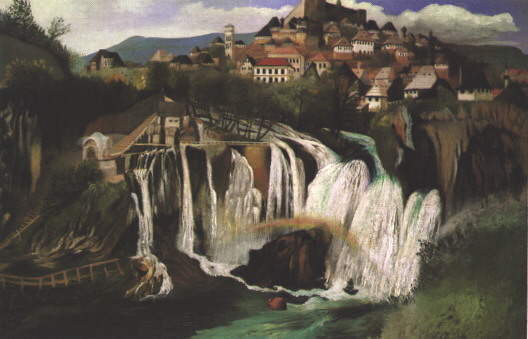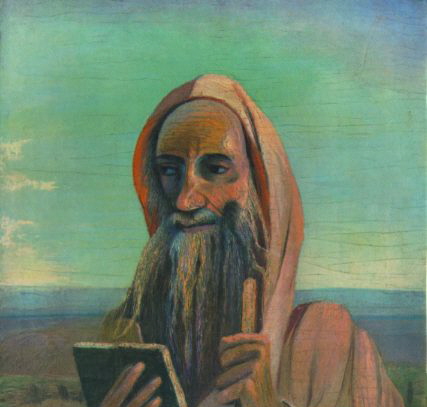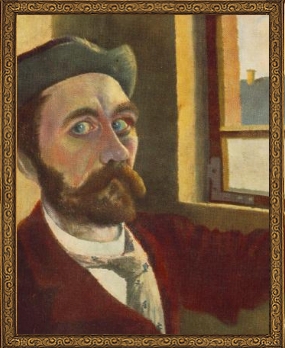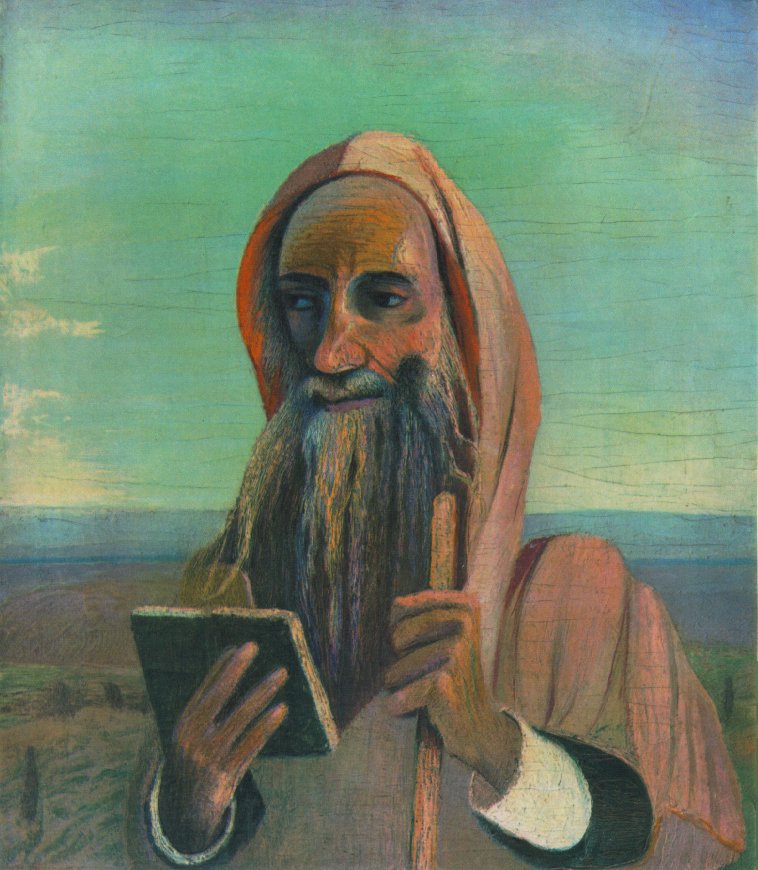Tivadar Csontváry-Kosztka
1853 - 1919
![]()
Tivadar Csontváry Kosztka wurde am 5.Juli 1853 in der Kleinstadt Kisszeben geboren. Dem väterlichen Vorbild folgend (sein Vater Dr. László Kosztka, war Arzt und Apotheker) ergriff auch Csontváry die Apothekerlaufbahn.
Nach seinem Studium arbeitete er als angestellter Apotheker in Igló. Vermutlich aufgrund einer psychotischen Erkrankung (Schizophrenie) hatte er am 13. Oktober 1880 eine Vision, bei der ihm eine innere Stimme prophezeite, er würde ein größerer Maler werden als Raphael.
Methodisch machte sich Csontváry ans Werk. Es setzte sich zwanzig Jahre Zeit für die Erfüllung seiner Vision. Zunächst galt es, ein sicheres Einkommen zu erwirtschaften. Zu diesem Zweck gründete er eine 1884 Apotheke in Gács.
1894 begann er mit einundvierzig Jahren seine ersten intensiven Studien der Malerei. Der Maler Simon Hollósy in München gab ihm erste Impulse, danach studierte er in Karlsruhe und Paris. Aus diesem Zeitraum sind bereits erste Ölgemälde bekannt.
1896 bis 1904 folgten Reisen nach Italien und Dalmatien, Westeuropa und am Schluß auch Kairo, wo er endlich das von ihm gesuchte helle Licht des Südens fand. Während dieser Jahre malte er in einem naiv-realistischen Stil.
1904 hatte Cssontváry endlich sein selbstgesetztes Ziel erreicht und sich als Maler etabliert. Bilder aus der Tatra und Bilder aus Athen folgten. 1905 eröffnete er in Budapest seine erste Ausstellung. 1907 folgte eine Ausstellung im Palais de Glace in Paris, wo Csontváry internationale Bestkritiken erntete. 1908 fand eine weitere Ausstellung in Budapest statt.
Csontváry hatte sich zwischenzeitlich mystischen und biblischen Szenen zugewandt. Jedoch fand er trotz guter Kritiken nicht den Ruhm, den ihm seine Vision verheißen hatte. Einsamkeit und das Gefühl, als Künstler nicht verstanden zu werden, setzten ihm dermaßen zu, daß seine Geisteskrankheit akut wurde und ihn auch an weiterer Malerei hinderte. 1909 malte er sein letztes Bild in Neapel, “Strandritt”.
Danach erlaubte ihm sein Zustand kein künstlerisches Schaffen mehr. Seine letzten Malereien waren nur noch Fragmente und surreale Skizzen.
Am 20. Juni 1919 starb Tivadar Csontváry Kosztka in Budapest.
Tivadar Csontváry Kosztka was born Juli 5th,1853 at the small town of Kisszeben in Hungary. His father Dr. László Kosztka was a physician as well as a pharmacist, so Tivadar Csontváry Kosztka decided to follow suit and became a pharmacist as well.
After his studies he worked some time as a pharmacist at Igló. October 13th, 1880 he had a vision, probabely due to a developing psychotic disease (schiziphrenia). This vision revealed to him that he would become famous as a painter, more famous in fact than the renown artist Raphael.
Csontváry started methodically. He estimated he would need twenty years to fullfill his vision. First he needed a solid financial base. So he founded a pharmacy at Gács.
1894 he started to study painting, first with the paiter Simon Hollósy at Munic, later he studied at Karlsruhe and Paris. A few oil paintings resulted from this early period.
From 1896 till 1904 he travelled to Italy, Dalmatia, western Europe and at last to Kairo (Egypt), where he found the brilliant light of the south he had all the time been looking for. During these years he painted in a naive-realistic-style.
1904 Csontváry found that he had reached his goal to become an well-known and establishesd painter. 1905 he started his first exhibit at Budapest. 1907 folowed an exhibit at the Palais de Glace at Paris /France, where he got international praise for his work. 1908 followed another exhibit at Budapest.
In the meantime Csontváry had started to paint religious and mythological themes. Despite his achievements the critics didn´t praise him as the great artist his visions had promised him to be.
He felt misunderstood as an artist. Together with his loneliness and added by his mental disposition this feeling developed into insanety. His mental illness hindered his artistic work deeply. 1909 he painted his last picture at Neapel, namend "Riding on the Beach".
After that he wasn´t able to paint anymore. All he could still produce were fragments and surreal sketches.
On July 20th, 1919 Tivadar Csontváry Kosztka died at Budapest.

Die Verwendung der Bilder erfolgt mit freundlicher Genehmigung von Dr. Emil Kren, “Die feinen Künste in Ungarn”.
Use of pictures allowed by courtesy of Dr. Emil Kren, “Fine Arts in Hungary”.
http://www.hung-art.hu/index-en.html

Selbstportrait,
ca. 1900
Öl auf Leinwand, 67x39,5 cm
Ungarische Nationalgallerie, Budapest
Self-Portrait
c. 1900
Oil on canvas, 67 x 39,5 cm
Hungarian National Gallery, Budapest

Marokkanischer Lehrer
1908
Öl auf Leinwand, 75x65 cm
Janus Pannonius Museum, Pécs
Teacher in Morocco
1908
Oil on canvas, 75 x 65 cm
Janus Pannonius Museum, Pécs
Wasserfall bei Jajce
1903
Ol auf Leinwand, 97x149 cm
Janus Pannonius Museum, Pécs
Waterfall at Jajce
1903
Oil on canvas, 97 x 149 cm
Janus Pannonius Museum, Pécs
|
To the galleries Artists A-Z Artists by year of birth Search by picture Search by portrait Impressum Sitemap |

